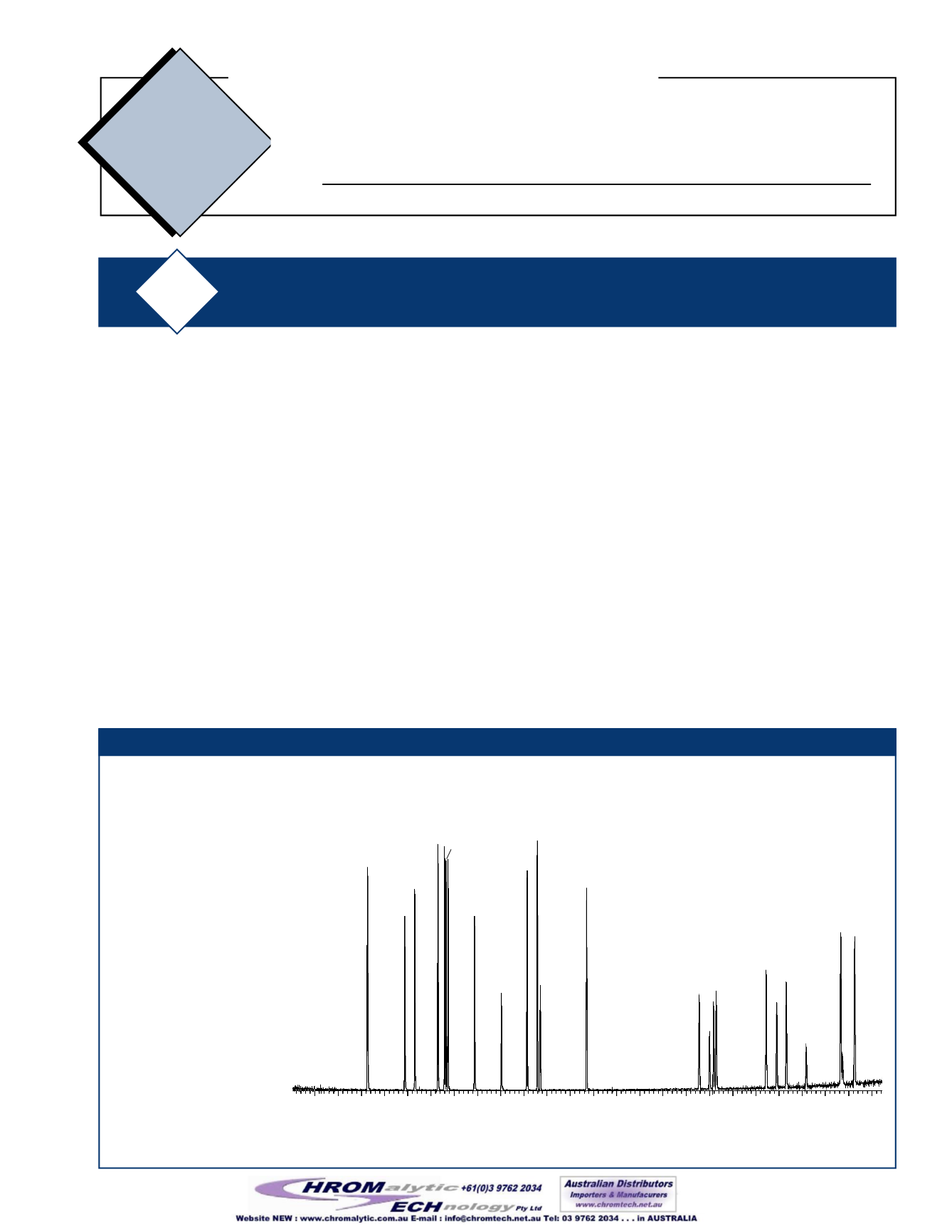
Industrial Chemicals
RestekCorporation
(800) 356-1688
A
pplicationsnote
Lit. cat.# 59552
GC/MSAnalysis ofAzoDyeCompounds
Some consumer goods that come into contactwith thehuman
body, such as clothing, jewelry, and toys,may contain azodyes
thatmetabolize into carcinogenic aryl amines. Consumer safety
regulations inGermanyprohibit thedistributionof all consumer
goods containing azodyes,
1
andotherEuropean countriesmay
follow suit in thenear future. In1996, theGermangovernment
instituteBgVVpublished fourmethods for azodye analysis,
including agas chromatography (GC)method.
2
Analystsmust overcome several obstacleswhenperforming a
GC analysis of aryl amines. First, response factors rise for the
first several injections before reaching an equilibrium state,
especiallywhenusing standard sleeve,wool, and column
deactivation.Restek’s proprietary aminedeactivation for inlet
liners andwool,whenused in combinationwith theRtx
®
-5
Amine column,will eliminate the adsorption that causes this
“priming effect.”As a result, the reproducibilityof the analysis
alsowill improve. Second, the inability toobtainpure, stable
calibration standards is aproblem. Rawmaterial characterization
andpurification is essential for thepreparationof suitable
calibration standards. Restek’s azodye standards offer themost
pure and stable calibration available. The followingdescribes an
optimizedgas chromatography/mass spectrometry (GC/MS)
methodof azodye analysis, basedon theGermanmethod
(Figure1).
Sample Preparation
1gofmaterial (e.g. leather or cotton) is solvated in17mLof
60mM, pH6 sodium citrate buffer at 70°C for 30minutes.Add
3mLof 20% sodiumdithionite to the sample andheat at 70°C
for 30minutes to chemically reduce the azodyes into aryl
amines.
SampleExtraction
Samplesmaybe extracted and concentrated for analysis using
solidphase extraction (SPE) or liquid/liquid extraction.
Procedure#1, SolidPhaseExtraction
This procedureusesE.MerckExtrelut
®
20 cartridges or
equivalent.The aqueous, chemically-reduced samples are loaded
onto the activated cartridges and allowed to stand for 5minutes.
30m, 0.25mm ID, 0.25µmRtx
®
-5Amine (cat.# 12323). 1µL splitless injection using a 4mm gooseneck sleevewith base deactivatedwool forHPGCs (cat.# 20798-211.1).
Concentration:
10µg/mL in ethylacetate.
Oven temp.:
50°C to200°C@10°C/min. to270°C@5°C/min.;
Inj./det. temp.:
250°/300°;
Carrier gas:
helium@1mL/min.;
Detector type:
MSD;
Splitless hold time:
1min.
1.
o
-toluidine
2. 2-methoxyaniline
3. 4-chloroaniline
4. 2-methoxy-5-methylaniline
5. 2,4,5-trimethylaniline
6. 3-chloro-2-methylaniline
7. 4-chloro-2-methylaniline
8. 2,4-diaminotoluene
9. 2,4-diaminoanisole
10. 2-naphthylamine
11. 2-aminobiphenyl
12. 2-methyl-5-nitroaniline
13. 4-aminobiphenyl
14. 4-phenylazoaniline
15. 4-aminophenylether
16. benzidine
17. bis-(4-aminophenyl)-methane
18. 4'-amino-2,3'-dimethylazobenzene
19. 4,4'-diamino-3,3'-dimethyldiphenylmethane
20. 3,3'-dimethylbenzidine
21. 4-aminophenylthioether
22. 3,3'-dichlorobenzidine
23. 4,4'-methylene-bis(2-chloroaniline)
24. 3,3'-dimethyoxybenzidine
25. 3,3',5,5'-tetramethyl benzidine (IS)
Figure 1
Restek’s proprietary amine deactivated sleeves, fused silicawool, andRtx
®
-5Amine columns combine togive
exceptional response for azo dyes, evenwhen analyzed at the low 10µg/mL concentration.
min. 8
10
12
14
16
18
20
22
24
26
28
30
1
2
3
4 5
6
7
8
9
10
11
12
13
14
15
16
17
18
19
20
21
22,23
24
25 (IS)


